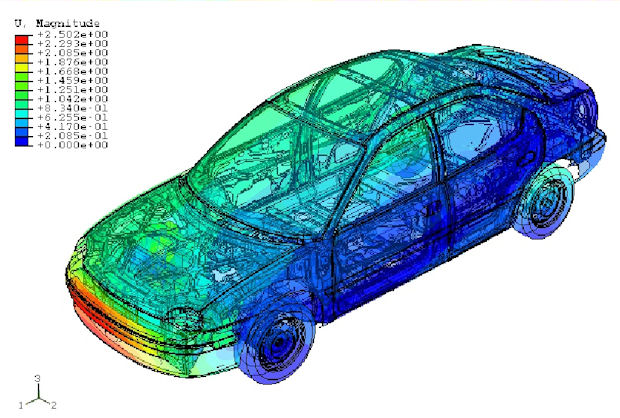Drive Automotive Innovation with Simulation
Latest News
June 30, 2014
 Dear Desktop Engineering Reader:
Dear Desktop Engineering Reader:
Minimizing NVH (noise, vibration and harshness) is a big deal for automotive manufacturers. It’s one of the many reasons why the automotive industry is such a heavy user of FEA (finite element analysis), multiphysics and other optimization technologies. Simulation can help you improve designs and product quality efficiently and cost-effectively. Simulation can lead to more innovation and provide a boost to your return on investment.
Still, analyzing for NVH is as much of an art as it is an engineering challenge. Today’s Check it Out link takes you to the “Driving Automotive Innovation with Realistic Simulation” landing page created by Dassault SIMULIA. Here you’ll have access to a set of four technical briefs that can help you become more artful when analyzing for NVH.
A quick word to the wise: While geared toward users of the Abaqus family of simulation solutions and automotive applications, these papers are good, meaty technical reads. Abaqus users will benefit from the tutorial nature of the demonstrations, of course. But the curious engineer and the engineer working on NVH phenomena in any industry will still enjoy these top-notch technical briefs.
The briefs range from four to six pages long, and they follow the standard technical paper “summary, intro, main text and conclusion” format. All are abundantly illustrated with screen captures and graphs. They have reference materials for further details. Of special note to existing and potential Abaqus users are the software’s key features and benefits detailed in a bulleted callout box for each particular application discussed. Here’s a quick look at each tech brief.
“Full Vehicle NVH Analysis with Rolling Tires” illustrates the use of a dynamic substructure in an NVH analysis of a full vehicle model with steadily rolling tires. What’s of concern here is that traditional NVH analyses define stationary tires and subject them to vertical dynamic loading. But car tires are meant to roll, and the vibration characteristics of rolling tires differ considerably from those of stationary tires. This paper presents a simulation demonstrating an analysis methodology that includes the effect of rolling tires on a vehicle’s forced frequency response.
The issue in “Noise, Vibration, and Harshness (NVH) Analysis of a Full Vehicle Model” is accuracy and time to solution. Specifically, the accuracy of mode-based finite element procedures for analyzing NVH performance increases if you increase the associated frequency range to include a larger fraction of the audible spectrum. But doing so makes your model much bigger, so you need more efficient numerical techniques to keep analysis times within reason. The paper demonstrates how to perform mode-based analyses of a full automobile model using the Abaqus product suite and what benefits you could derive.
“Sound Radiation Analysis of Automobile Engine Covers” demonstrates a methodology for studying the sound radiation of engine valve covers. Analyzing noise radiation from the valve cover involves modeling the adjacent air, which is of infinite extent. Directly modeling infinite air domain with finite elements is not practical. You can, however, simulate the effect of infinite extent through the use of acoustic infinite elements or impedance treatments on the boundary of a truncated mesh of acoustic finite elements.
Abaqus allows pre-loading and gyroscopic effects to be included in a complex frequency extraction. This capability can enable you to predict a rolling tire’s frequencies and mode shapes. “Vibration Characteristics of Rolling Tires” summarizes an analysis methodology using Abaqus that can help you determine the vibration characteristics of steadily rolling and stationary tires.
The four papers available on Dassault SIMULIA’s “Driving Automotive Innovation with Realistic Simulation” are thoroughly engaging. While they cover the Abaqus suite of simulation tools, there’s not a whiff of marketing in them. A single registration gets you access to the four papers. Hit today’s Check it Out link and see for yourself.
Thanks, Pal. – Lockwood
Anthony J. Lockwood
Editor at Large, Desktop Engineering
Subscribe to our FREE magazine, FREE email newsletters or both!
Latest News
About the Author
Anthony J. Lockwood is Digital Engineering’s founding editor. He is now retired. Contact him via [email protected].
Follow DE






